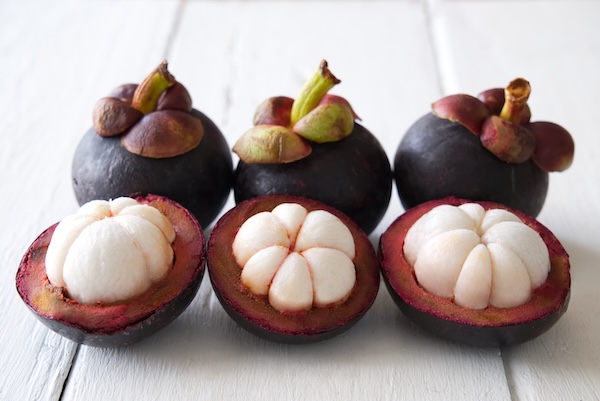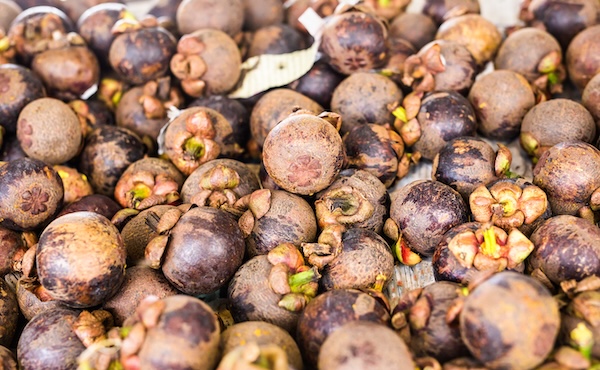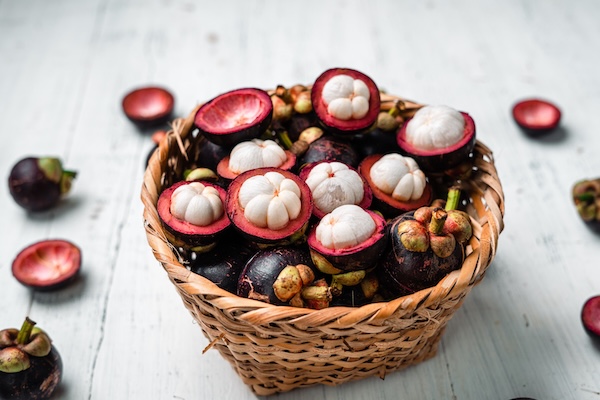Mangosteen in Thailand: A Royal and Refreshing Delight
Nicknamed the “queen of fruits,” the Thai mangosteen is one of the most delicate and elegant treasures you’ll find in Southeast Asian markets. Beneath its thick, deep purple rind lies a fragrant, juicy white flesh with a flavor often described as a mix of peach, lychee, and citrus.
Known locally as “mangkhut” (มังคุด), this fruit enchants both the eye and the palate. It’s not only popular throughout Asia but also praised in traditional medicine for its many health benefits.
Legend has it that Queen Victoria of England loved mangosteen so much she offered knighthood to anyone who could bring it to her from Asia. Today, it still holds that royal allure on the colorful stalls of Thai markets.
When to Eat Mangosteen in Thailand?
🌧️ Mangosteen Season
The best time to enjoy mangosteen in Thailand is from May to August, during the rainy season. The humid climate is ideal for its growth, and market stalls are filled with these little purple gems.
📍 Popular Growing Regions
- Chanthaburi: Famous for producing some of the country’s finest mangosteens.
- Trat and Rayong: Productive eastern provinces with rich soil.
- Southern Thailand: The climate ensures abundant harvests.
Agricultural festivals sometimes celebrate the mangosteen harvest, where you can taste different varieties, learn how to pick the best ones, and even join tasting contests!
How to Choose a Good Mangosteen?
Here are a few tips for picking the perfect fruit:
- Gently soft shell (avoid dry or rock-hard ones)
- Fresh green crown (not brown or dry)
- No cracks on the rind (a sign of overripeness)
Once opened, it reveals pearly white segments nestled inside like a delicate flower in a purple shell.
Fun fact: The number of white segments inside usually matches the number of “petals” seen at the bottom of the fruit — a secret often shared by Thai market vendors!
Where to Buy Mangosteen in Thailand?
🛍️ Traditional Markets
Mangosteen is a superstar in Thai markets. You’ll often find it sold loose by weight, ranging from 30 to 80 baht per kilo, depending on the season and region.
🛒 Supermarkets and Online
It’s also available in big grocery chains, carefully sorted and packaged. In urban areas, you can even order it online through various local delivery platforms.
Health Benefits of Thai Mangosteen
💪 Packed with Antioxidants
Mangosteen contains powerful antioxidants called xanthones, which help fight oxidative stress and inflammation, as noted by WebMD.
🍊 Nutrients and Vitamins
- Vitamin C: Immune system booster
- Potassium: Helps regulate blood pressure
- Fiber: Supports healthy digestion
With around 70 kcal per 100g, it’s a guilt-free snack for fruit lovers.
Traditional Thai medicine also uses dried mangosteen peel in decoctions to relieve stomach issues and skin inflammation.
A Fruit Rooted in Royalty and Tradition
Mangosteen’s appeal goes beyond its flavor. It has a rich cultural heritage. Once considered a luxury fruit reserved for royalty in Southeast Asia, it’s long been used in Thai and Chinese traditional medicine for its anti-inflammatory properties — especially for skin infections, digestive problems, and fevers.
The rind, often discarded, is actually prized when dried and brewed, said to purify the body and soothe joint pain. Today, mangosteen extracts are even found in natural supplements and skincare products thanks to their antioxidant effects.
How to Enjoy Mangosteen?
🍽️ Fresh, by Hand
The most common way to eat mangosteen is fresh and raw. Gently press the rind until it cracks open, then scoop out the segments with a spoon.
🧁 In Juices, Desserts, and Smoothies
- Blended into a smoothie with crushed ice
- Made into homemade jam
- Used in local pastries, especially as jellies or mousses
Some fine dining restaurants in Bangkok even use mangosteen in savory dishes like tropical salads and seafood carpaccio.
🌸 A Sacred Fruit in Asian Culture
In neighboring countries like Malaysia and Indonesia, mangosteen is seen as a fruit of royalty and purity. In Thailand, it remains one of the most beloved fruits across generations — a national favorite.
Can You Bring Mangosteen Back to France?
Like many fresh tropical fruits, you cannot bring mangosteen to France in its raw form due to phytosanitary regulations. But you can bring home:
- Mangosteen candy
- Dried or freeze-dried mangosteen
- Cosmetic products made with mangosteen extract (creams, soaps)
What to Remember About Mangosteen in Thailand
- Best season: May to August
- Taste: Delicate, floral, and refreshing
- Health: Antioxidant-rich, low in calories
- Symbolism: Associated with purity and royalty in Asia
- Tip: A must-try when visiting Thai markets!
👉 Want to explore more iconic Thai fruits? Check out our article on the Thai durian — the “king of fruits.”



